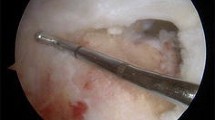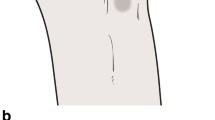Abstract
Background
Traditional intra-articular arthroscopic repair techniques for massive anterosuperior rotator cuff tears are technically demanding and necessitate sacrifice of the rotator interval to enable visualization. An interval slide allows mobilization through release of the medial aspect of the rotator interval, while leaving the lateral, bridging fibers intact.
Questions/Purposes
The purpose of this study was to report a novel, arthroscopic, open-equivalent technique using the subdeltoid space to address these tears along with early clinical results.
Methods
A retrospective review of prospectively collected data identified 11 consecutive arthroscopic massive anterosuperior rotator cuff repairs with a concomitant biceps tenodesis performed by the senior surgeon using a uniform technique. Outcome measures included range of motion, visual analog scale for pain, rotator cuff strength, American Shoulder and Elbow Surgeons (ASES) outcome scale, and Short Form-12 (SF-12).
Results
Average length of follow-up was 22.2 months (range 12.5–30.0 months). Visual analog scale (VAS) pain scores, ASES, and SF-12 all demonstrated significant improvement from pre-op to final follow-up from 6.2 to 0.9 (p < 0.05), 27.4 to 82.8 (p < 0.05), and 26.6 to 45.5 (p < 0.05) respectively. Average forward flexion improved from 145° to 160° (p < 0.05). Seven of the nine patients with a positive preoperative belly press had a negative test at final follow-up. Nine of the 10 patients with a positive lift off test demonstrated a negative test on final follow-up. Ninety-one percent reported they were satisfied with their outcome.
Conclusions
The described modified all-arthroscopic subdeltoid approach for anterosuperior cuff repairs enabled an open-equivalent interval slide technique that preserved the bridging lateral fibers of the rotator interval and demonstrated promising early-term clinical results.






Similar content being viewed by others
References
Arai R, Nimura A, Yamaguchi K, et al. The anatomy of the coracohumeral ligament and its relation to the subscapularis muscle. J Shoulder Elb Surg. 2014. doi:S1058-2746(14)00119-0.
Bartl C, Senftl M, Eichhorn S, et al. Combined tears of the subscapularis and supraspinatus tendon: clinical outcome, rotator cuff strength and structural integrity following open repair. Arch Orthop Trauma Surg. 2012; 132(1): 41-50. doi:10.1007/s00402-011-1400-8.
Bennett WF. Subscapularis, medial, and lateral head coracohumeral ligament insertion anatomy. Arthroscopic appearance and incidence of “hidden” rotator interval lesions. Arthroscopy. 2001; 17(2): 173-180.
Bennett WF. Visualization of the anatomy of the rotator interval and bicipital sheath. Arthroscopy. 2001; 17(1): 107-111. doi:10.1053/jars.2001.21024.
Bennett WF. Arthroscopic repair of massive rotator cuff tears: a prospective cohort with 2- to 4-year follow-up. Arthroscopy. 2003; 19(4): 380-390. doi:10.1053/jars.2003.50131.
Burkhart SS, Esch JC, Jolson RS. The rotator crescent and rotator cable: an anatomic description of the shoulder’s “suspension bridge”. Arthroscopy. 1993; 9(6): 611-616.
Chalmers PN, Frank RM, Gupta AK, et al. All-arthroscopic patch augmentation of a massive rotator cuff tear: surgical technique. Arthrosc Tech. 2013; 2(4): e447-51. doi:10.1016/j.eats.2013.07.003.
Cole BJ, Rodeo SA, O'Brien SJ, et al. The anatomy and histology of the rotator interval capsule of the shoulder. Clin Orthop Relat Res. 2001; 390: 129-137.
Denard PJ, Burkhart SS. Medialization of the subscapularis footprint does not affect functional outcome of arthroscopic repair. Arthroscopy. 2012; 28(11): 1608-1614. doi:10.1016/j.arthro.2012.02.030.
Drakos MC, Verma NN, Gulotta LV, et al. Arthroscopic transfer of the long head of the biceps tendon: functional outcome and clinical results. Arthroscopy. 2008; 24(2): 217-223. doi:10.1016/j.arthro.2007.07.030.
Flury MP, John M, Goldhahn J, et al. Rupture of the subscapularis tendon (isolated or in combination with supraspinatus tear): when is a repair indicated? J Shoulder Elb Surg. 2006; 15(6): 659-664. doi:10.1016/j.jse.2005.07.013.
Foad A, Wijdicks CA. The accuracy of magnetic resonance imaging and magnetic resonance arthrogram versus arthroscopy in the diagnosis of subscapularis tendon injury. Arthroscopy. 2012; 28(5): 636-641. doi:10.1016/j.arthro.2011.10.006.
Galatz LM, Ball CM, Teefey SA, et al. The outcome and repair integrity of completely arthroscopically repaired large and massive rotator cuff tears. J Bone Joint Surg Am. 2004; 86-A(2): 219-224.
Gerber C, Fuchs B, Hodler J. The results of repair of massive tears of the rotator cuff. J Bone Joint Surg Am. 2000; 82(4): 505-515.
Gerber C, Hersche O, Farron A. Isolated rupture of the subscapularis tendon. J Bone Joint Surg Am. 1996; 78(7): 1015-1023.
Han Y, Shin JH, Seok CW, et al. Is posterior delamination in arthroscopic rotator cuff repair hidden to the posterior viewing portal? Arthroscopy. 2013; 29(11): 1740-1747. doi:10.1016/j.arthro.2013.08.021.
Harryman DT 2nd, Sidles JA, Harris SL, et al. The role of the rotator interval capsule in passive motion and stability of the shoulder. J Bone Joint Surg Am. 1992; 74(1): 53-66.
Ide J, Tokiyoshi A, Hirose J, et al. Arthroscopic repair of traumatic combined rotator cuff tears involving the subscapularis tendon. J Bone Joint Surg Am. 2007; 89(11): 2378-2388. doi:10.2106/JBJS.G.00082.
Itoi E, Berglund LJ, Grabowski JJ, et al. Superior-inferior stability of the shoulder: role of the coracohumeral ligament and the rotator interval capsule. Mayo Clin Proc. 1998; 73(6): 508-515. doi:S0025-6196(11)63515-5.
Kim DY, Yoo YS, Lee SS, et al. Arthroscopic percutaneous repair of anterosuperior rotator cuff tear including biceps long head: a 2-year follow-up. Clin Orthop Surg. 2012; 4(4): 284-292. doi:10.4055/cios.2012.4.4.284.
Kreuz PC, Remiger A, Erggelet C, et al. Isolated and combined tears of the subscapularis tendon. Am J Sports Med. 2005; 33(12): 1831-1837. doi:10.1177/0363546505277118.
Lafosse L, Jost B, Reiland Y, et al. Structural integrity and clinical outcomes after arthroscopic repair of isolated subscapularis tears. J Bone Joint Surg Am. 2007; 89(6): 1184-1193. doi:10.2106/JBJS.F.00007.
Levy JC. Simultaneous rotator cuff repair and arthroscopic biceps tenodesis using lateral row anchor. Arthrosc Tech. 2012; 1(1): e1-4. doi:10.1016/j.eats.2011.12.003.
Lo IK, Burkhart SS. The comma sign: an arthroscopic guide to the torn subscapularis tendon. Arthroscopy. 2003; 19(3): 334-337. doi:10.1053/jars.2003.50080.
Lo IK, Burkhart SS. Arthroscopic repair of massive, contracted, immobile rotator cuff tears using single and double interval slides: technique and preliminary results. Arthroscopy. 2004; 20(1): 22-33. doi:10.1016/j.arthro.2003.11.013.
Lo IK, Burkhart SS. The interval slide in continuity: a method of mobilizing the anterosuperior rotator cuff without disrupting the tear margins. Arthroscopy. 2004; 20(4): 435-441. doi:10.1016/j.arthro.2004.01.016.
Maschi R, Fives G. Rotator cuff repair: arthroscopic and open. In: Cioppa-Mosca J, Cahill J, Young Tucker C, editors. Postsurgical rehabilitation guidelines for the orthopedic clinician; 2006.
Mesiha MM, Derwin KA, Sibole SC, et al. The biomechanical relevance of anterior rotator cuff cable tears in a cadaveric shoulder model. J Bone Joint Surg Am. 2013; 95(20): 1817-1824. doi:10.2106/JBJS.L.00784.
Michener LA, McClure PW, Sennett BJ. American Shoulder and Elbow Surgeons Standardized Shoulder Assessment Form, patient self-report section: reliability, validity, and responsiveness. J Shoulder Elb Surg. 2002; 11(6): 587-594. doi:10.1067/mse.2002.127096.
Morag Y, Bedi A, Jamadar DA. The rotator interval and long head biceps tendon: anatomy, function, pathology, and magnetic resonance imaging. Magn Reson Imaging Clin N Am. 2012; 20(2): 229-59, x. doi:10.1016/j.mric.2012.01.012.
Namdari S, 3rd Henn RF, Green A. Traumatic anterosuperior rotator cuff tears: the outcome of open surgical repair. J Bone Joint Surg Am. 2008; 90(9): 1906-1913. doi:10.2106/JBJS.F.01446.
Neer CS 2nd. Displaced proximal humeral fractures: part I. Classification and evaluation. 1970. Clin Orthop Relat Res. 2006; 442: 77-82. doi:00003086-200601000-00014.
Nho SJ, Frank RM, Reiff SN, et al. Arthroscopic repair of anterosuperior rotator cuff tears combined with open biceps tenodesis. Arthroscopy. 2010; 26(12): 1667-1674. doi:10.1016/j.arthro.2010.04.008.
O'Brien SJ, Taylor SA, DiPietro JR, et al. The arthroscopic “subdeltoid approach” to the anterior shoulder. J Shoulder Elb Surg. 2013; 22(4): e6-10. doi:10.1016/j.jse.2012.09.006.
Park JY, Jung SW, Jeon SH, et al. Arthroscopic repair of large U-shaped rotator cuff tears without margin convergence versus repair of crescent- or L-shaped tears. Am J Sports Med. 2014; 42(1): 103-111. doi:10.1177/0363546513505425.
Plancher KD, Johnston JC, Peterson RK, et al. The dimensions of the rotator interval. J Shoulder Elb Surg. 2005; 14(6): 620-625. doi:S1058-2746(05)00101-1.
Resnick B, Parker R. Simplified scoring and psychometrics of the revised 12-item Short-Form Health Survey. Outcomes Manag Nurs Pract. 2001; 5(4): 161-166.
Richards DP, Burkhart SS, Tehrany AM, et al. The subscapularis footprint: an anatomic description of its insertion site. Arthroscopy. 2007; 23(3): 251-254. doi:10.1016/j.arthro.2006.11.023.
Schnaser E, Toussaint B, Gillespie R, et al. Arthroscopic treatment of anterosuperior rotator cuff tears. Orthopedics. 2013; 36(11): e1394-400. doi:10.3928/01477447-20131021-20.
Toussaint B, Audebert S, Barth J, et al. Arthroscopic repair of subscapularis tears: preliminary data from a prospective multicentre study. Orthop Traumatol Surg Res. 2012; 98(8 Suppl): S193-200. doi:10.1016/j.otsr.2012.10.004.
Walch G, Nove-Josserand L, Levigne C, et al. Tears of the supraspinatus tendon associated with “hidden” lesions of the rotator interval. J Shoulder Elb Surg. 1994; 3(6): 353-360. doi:10.1016/S1058-2746(09)80020-7.
Author information
Authors and Affiliations
Corresponding author
Ethics declarations
Conflict of Interest
Keith T. Corpus, MD, Samuel A. Taylor, MD, Stephen J. O’Brien, MD, MBA, and Lawrence V. Gulotta, MD have declared that they have no conflict of interest.
Human/Animal Rights
All procedures followed were in accordance with the ethical standards of the responsible committee on human experimentation (institutional and national) and with the Helsinki Declaration of 1975, as revised in 2008 (5).
Informed Consent
Informed consent was waived from all patients for being included in the study.
Required Author Forms
Disclosure forms provided by the authors are available with the online version of this article.
Additional information
Level of Evidence
Case series, Level of evidence IV
Electronic Supplementary Material
Below is the link to the electronic supplementary material.
ESM 1
(PDF 1225 kb)
Rights and permissions
About this article
Cite this article
Corpus, K.T., Taylor, S.A., O’Brien, S.J. et al. All-Arthroscopic Modified Rotator Interval Slide for Massive Anterosuperior Cuff Tears Using the Subdeltoid Space: Surgical Technique and Early Results. HSS Jrnl 12, 200–208 (2016). https://doi.org/10.1007/s11420-016-9497-5
Received:
Accepted:
Published:
Issue Date:
DOI: https://doi.org/10.1007/s11420-016-9497-5




